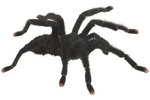
While trapdoor spiders exhibit interesting feeding behavior, most of the time they stay out of sight, tucked away in their burrows. The husbandry of trapdoor spiders is challenging, and little information regarding their care is available. Though they are not appropriate pets for beginners, experienced hobbyists may enjoy the challenge of keeping African trapdoor spiders.
Classification
Unlike “true spiders” of the suborder Araneomorphae, whose fangs move in a horizontal plane, trapdoor spiders have vertically oriented fangs like tarantulas. Scientists classify trapdoor spiders and tarantulas as members of the suborder Mygalomorphae. They debate the lower classification of the group and describe new species regularly: as recently as 2012, researchers Ian Engelbrecth and Lorenzo Prednini described three new species of trapdoor spider and published their work in the journal “American Museum Novitates.” Even more impressively, a 2012 paper by Jason E. Bond published in “ZooKeys” described 33 new species within one genus. According to Professor Ansie Dippenaar-Schoeman of the University of Pretoria in South Africa, over 200 species, representing five familes and 16 genera of trapdoor spider, are native to South Africa.
Enclosure
Use a 10-gallon aquarium with a tight-fitting screen lid to house your trapdoor spider. You do not need to add any other items to the cage, but you can add logs, rocks or plants for aesthetic purposes. The area immediately around the burrow should be free of items. Temperature requirements for the species are not known; warm room temperatures are likely sufficient. If your trapdoor spider builds a burrow but does not eat, it may be helpful to raise the temperature slowly over time, in increments of 2 to 3 degrees Fahrenheit. Use a small light for the aquarium, and turn it on and off in a 12-hour cycle; trapdoor spiders are primarily nocturnal and may not feed in constant “daytime” conditions.
Substrate
The most important and difficult aspect of maintaining trapdoor spiders is providing a suitable substrate. Use one that is similar to that found in the natural habitat of your species. This can be difficult to determine given the sometimes-sloppy identification of specimens in the pet trade. Peat moss or organic potting soil is a good substrate for a species from regions with high humidity; sand is a good substrate for species from arid regions. Some specimens will not build their own burrows, so it may be necessary to dig one for your new spider. Some species may prefer their substrate to have a slight slope. Regardless of the type of substrate used, it must be deep: 6 to 10 inches of depth is required.
Feeding Your Trapdoor Spider
In the wild, African trapdoor spiders construct burrows and line them with silk. They create a trapdoor of nearby materials and hinge it to the burrow with silk. The spiders stretch many “trip wires” around the exterior of the hole to alert the spider when prey is within range. The spiders wait in their burrows, holding the trapdoor, and waiting for prey to touch one of the trip wires. Hungry spiders may wait at the entrance of the burrow, with the trapdoor slightly ajar. In captivity, you must allow your spider to engage in these natural behaviors in order to feed. Drop a live cricket or roach into the habitat once every seven to 14 days.
Caution
Like most spiders and tarantulas, African trapdoor spiders are venomous. The scientific community does not yet understand the venom’s effects well, so exercise care when working with them. Use tools to maintain the cage while the spider is inside it—if you trip one of the silk trip wires, the spider may mistake you for prey. Many species are nervous and quick to react defensively.
References
- American Museum Novitates: Cryptic Diversity of South African Trapdoor Spiders: Three New Species of Stasimopus Simon, 1892 (Mygalomorphae, Ctenizidae), and Redescription of Stasimopus Robertsi Hewitt, 1910
- ZooKeys: Phylogenetic Treatment and Taxonomic Revision of the Trapdoor Spider Genus Aptostichus Simon (Araneae, Mygalomorphae, Euctenizidae)
- Science in Africa: Trapdoor Spiders Mean Business
- Plant Protection Research Institute: Baboon and Trapdoor Spiders of Southern Africa: An Identification Manual [PDF]
- CC's Treasures and Reptiles: Spiders and Tarantulas [PDF]
- petbugs.com: Malaysian Trapdoor Spider
Photo Credits
-
Creatas/Creatas/Getty Images



